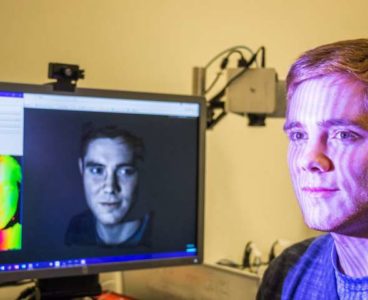A new theory could enable researchers and industry to tune and improve the performance of a material called ionic ceramics in rechargeable batteries, fuel cells and other energy applications. Ionic ceramics are made up of many faceted “grains” that meet at boundaries in ways that affect, for example, how much power a fuel cell can…
Super-Strong Aluminum Alloy Rivals Stainless Steel
Researchers have demonstrated how to create a super-strong aluminum alloy that rivals the strength of stainless steel, an advance with potential industrial applications. “Most lightweight aluminum alloys are soft and have inherently low mechanical strength, which hinders more widespread industrial application,” says Xinghang Zhang, a professor in Purdue University’s School of Materials Engineering. “However, high-strength,…
Semiconductors Reveal Secrets of their Heat
Researchers are applying the same “hydrodynamic transport model” used to study flow in fluids to explain heat transport in a solid semiconductor, with potential implications for the design of high-speed transistors and lasers. Thermal imaging of tiny nanoscale semiconductor heat sources revealed details about vortices of heat-carrying objects called phonons. The new findings have potentially…
New C-BRIC Center Will Tackle Brain-inspired Computing
Purdue University will lead a new national center to develop brain-inspired computing for intelligent autonomous systems such as drones and personal robots capable of operating without human intervention. The Center for Brain-inspired Computing Enabling Autonomous Intelligence, or C-BRIC, is a five-year project supported by $27 million in funding from the Semiconductor Research Corp. (SRC) via…
‘Holostream’ Allows High-Quality Wireless 3D Video Communications
A new platform enables high-quality 3-D video communication on mobile devices such as smartphones and tablets using existing standard wireless networks. “To our knowledge, this system is the first of its kind that can deliver dense and accurate 3-D video content in real time across standard wireless networks to remote mobile devices such as smartphones…
Shark-like Quantum Material Detects Small Electrical Signals
A “quantum material” that mimics a shark’s ability to detect the minute electric fields of small prey has been shown to perform well in ocean-like conditions, with potential applications from defense to marine biology. The material maintains its functional stability and does not corrode after being immersed in saltwater, a prerequisite for ocean sensing. Surprisingly,…
Device Simulates Tumors as Efficiently as Research Animals
A new technology that simulates tumors has been shown to perform as well as research animals in testing chemotherapy drugs, representing a potential tool for screening drugs before treating a patient. A long-term goal is to incorporate biopsied cancer cells from patients and test the effectiveness of different drugs on the patient-derived cells, says Bumsoo…
Single “Solitons” Offer Hope for Optical Advancements
Researchers are a step closer to harnessing single pulses of light called solitons, using tiny ring-shaped microresonators, in findings that could aid efforts to develop advanced sensors, high-speed optical communications, and research tools. Being able to harness the solitons using devices small enough to fit on an electronic chip could bring a host of applications,…
Chemical Imaging System Penetrates Tissue with Lasers
A “chemical imaging” system that uses a special type of laser beam to penetrate deep into tissue might lead to technologies that eliminate the need to draw blood for analyses including drug testing and early detection of diseases such as cancer and diabetes. The system, called stimulated Raman projection microscopy and tomography, makes possible “volumetric…
Shellfish Help Create New Biodegradable Adhesive
A new type of adhesive that combines the bonding chemistry of shellfish with a bio-based polymer has been shown to perform as well as commercially available products and can be easily degraded, representing a potential non-toxic alternative. “Adhesives releasing toxins including carcinogenic formaldehyde are almost everywhere in our homes and offices. The plywood in our…
Semiconductor Hails Arrival of Next-Gen “Power Electronics”
Researchers have demonstrated the high-performance potential of an experimental transistor made of a semiconductor called beta gallium oxide, which could bring new ultra-efficient switches for applications such as the power grid, military ships, and aircraft. The semiconductor is promising for next-generation “power electronics,” or devices needed to control the flow of electrical energy in circuits.…
The Future of Semiconductor Electronic Devices
Purdue University researchers — during the international IEDM 2016 conference the week of Dec. 5 — showcased a range of concepts and technologies that foreshadow the future of the semiconductor industry. The concepts included innovations to extend the performance of today’s silicon-based transistors, along with entirely new types of nanoelectronic devices to complement and potentially…
Skin Patches Track Dehydration Levels
Researchers have developed a low-cost skin patch that changes color to indicate different levels of hydration, representing a potential new medical technology. Such an innovation might be used by marathon runners, military personnel, and others to help prevent dehydration. “Hydration in humans is a delicate parameter,” says Babak Ziaie, a professor of biomedical engineering and…
Durable “Skin-like Bandage” Monitors Biosignals
A skin-like biomedical technology that uses a mesh of conducting nanowires and a thin layer of elastic polymer might bring new electronic bandages that monitor biosignals for medical applications and provide therapeutic stimulation through the skin. The biomedical device mimics the human skin’s elastic properties and sensory capabilities. “It can intimately adhere to the skin…
Hybrid System Will Harvest “Full Spectrum” of Solar Energy
A new concept could bring highly efficient solar power by combining three types of technologies that convert different parts of the light spectrum and also store energy for use after sundown. Combining the technologies could make it possible to harness and store far more of the spectrum of sunlight than is possible using any one…
Electronic Sensor Distinguishes Dead Bacteria from Live
A new type of electronic sensor that might be used to quickly detect and classify bacteria for medical diagnostics and food safety has passed a key hurdle by distinguishing between dead and living bacteria cells. Conventional laboratory technologies require that samples be cultured for hours or longer to grow enough of the bacteria for identification…





